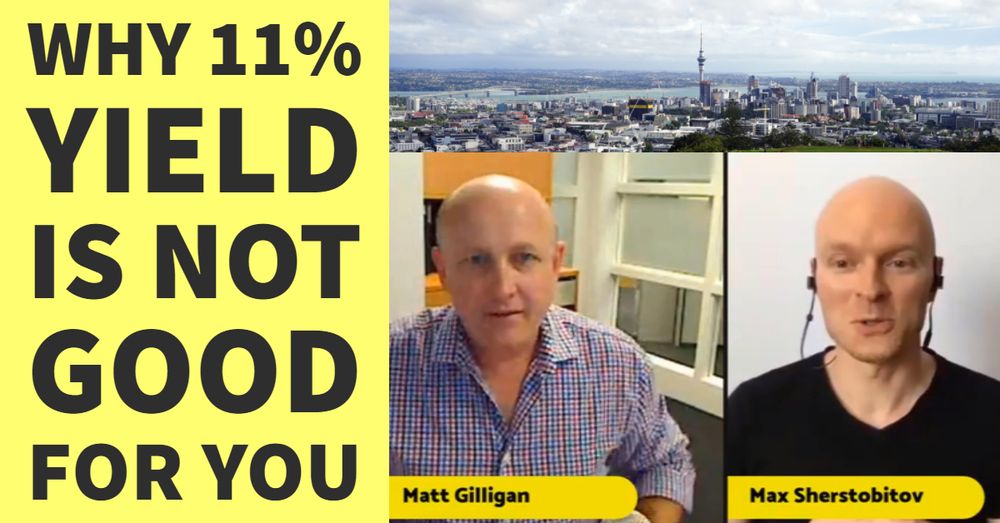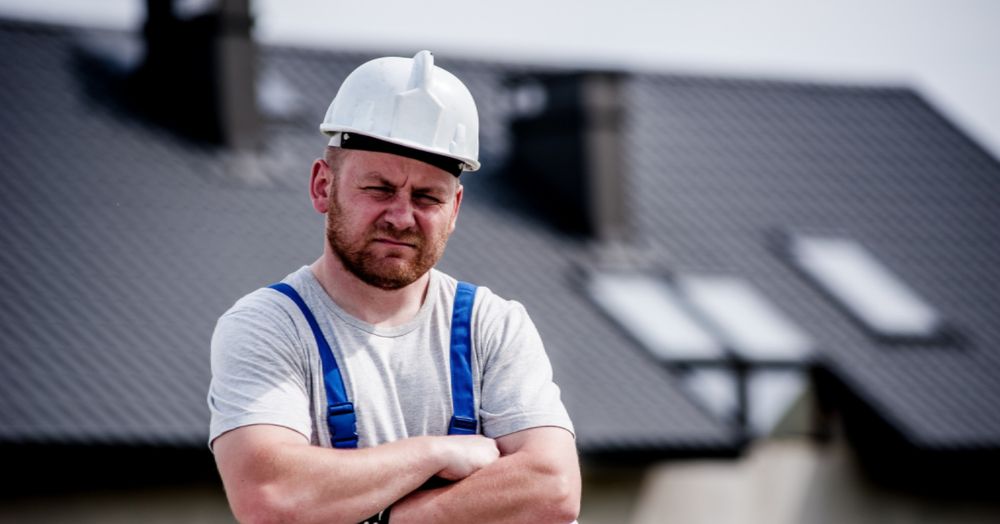
Max: How can you maximize returns from New Zealand property investment in 2018? Some of the things that we will cover are the new government and taxes, what’s making money in Auckland, what Matthew, our guest speaker, is doing right now and why, property cycles in Auckland
and the rest of New Zealand, why Matthew doesn’t like investing in small towns. We are starting right now.
My name is Max, and today my guest is Matthew Gilligan, who is the Managing Director of Gilligan, — and Associates, where he heads the Specialist Property and Asset Planning Division, helping clients build wealth and property, and creating optimal next structures.
Welcome, Matthew. How are you?
Matthew: Thanks, Max. It’s a pleasure to be here.
Max: You must be very busy. It’s a busy season for accountants, isn’t it?
Matthew: Yes. A little bit of introduction about myself. As said, my name’s Matthew Gilligan. I’m a chartered accountant, specializing in property and tax structures. I’m MD here at GRA. We are an Auckland based, New Market based chartered accounting firm, but we have clients all over the country.
I’ve written a couple of books, Tax Structures 101, Property 101. Over the years, I’ve been a consulting tax person. Behind me, I’ve got a team of accountants to do tax returns, financial statements, that sort of thing.
When I say I’m a tax consultant, I don’t do tax returns. I’ve never done tax returns. I read legislation and I provide opinions on what people can put on their tax returns, is a good way of describing it.
Or contingens things with IID. I’ve also done a lot of trust work. Behind me, I’ve got lawyers and very specialized tax people, that run our tax and asset planning team with me. Those are the first 15 years of my career.
In more recent years, I’ve become a full time property investor. I am predominantly involved in the development of property. In parallel, I’m still Managing Director at GRA. I head up our Property Education Services and provide a lot of consulting advice on property development and abasement, through their education business now.
While I am a chartered accountant, and I know to do a tax return, I don’t do tax returns. I am still involved in education, so I keep myself up to date from a tax perspective. Even the tax advisory work is done by the lawyers that work for me, and our tax team here at GRA now.
That’s just a little bit of an introduction on who I am, and what I do. I think the best way to describe me at the moment is a tax savvy property developer, because that’s what I spend my days educating people on, and most of my time is controlling development sites.
A few things to discuss today, and thank you very much, Max, for inviting me to be here to talk to your listeners. I’m pleased to be here.
Max: That’s alright. I appreciate it.
Matthew: — I have done you guys a beautiful presentation. Here it is, yeah. And at two minutes to four, I discovered that I can’t hear my slides on this education, so I can’t show them to you, but that’s okay. I can tell you all about them. If I need any props, I’ll hold them up to you and show them to you.
Max: Yeah. Actually, Matthew, if it’s okay with you, maybe some listeners would be interested in the slides. Maybe you can e-mail them later, or you can post on Facebook.
Matthew: I’d love to do that. Problem is, I’ve got lots of competitors who would like to use my slides, so I don’t necessarily give them out to the public.
Max: Okay. Fair enough.
Matthew: — taxes. We’ll go over some of the changes — quite topical, because they just raised an issue in the paper last week, on how they’re going to bring it. It’s different to what they said they were gonna do through the election.
Cycles and ripple effect, and how that will … how you can take advantage of that.

Why I don’t like small towns. When I say I don’t like them, they’re beautiful places, but I don’t want to put my money there.
What’s making money. When I say what’s making money, what’s making me money. Culturally, our approach here at GRA is to say we lead by example. If I’m teaching somebody about property development, I’ve personal experience at it, I’m making money at it.
If one of my staff is speaking about portfolio building, or buy and hold analysis. They are buy and hold –, borrowing lots of money, doing it themselves.
I personally own north of 30 properties. At the moment, I’ve got 11 development sites. They’re all three or four lot sites, so they’re small developments. I do … I buy the site, I do the subdivision.
I have my own civil works company that does my own civil works, and my own diggers, and my own contractors that work full time for me, as salaried employees. I farm out the building of the houses. That’s fixed by the contractor.
The rest of it, I handle. This whole experience, a lot of what we have is hands on. We might be CA’s, we may be clever academic people, but we are practical people with hands on experience.
I’m gonna talk about what’s making money in the context of what’s making me money. I’ll tell you about some of my numbers on some of my sites. Then I’m gonna say to you why what I do is not necessarily for all else, –.
Maybe give some ideas on what some smaller income or smaller capital based households might be considering doing, in this market. So, that’s my agenda, really.
Max, should we talk about — policy.
Max: Matthew, before we continue, I’d like to tell to all the viewers, if you’ve joined us right now, Matthew has a wealth of knowledge and you may well ask him anything during the talk right now. If he is able to answer, he will do it.
Otherwise, he may answer it later, after the Facebook live. So, feel free to write in your comments right now, and Matthew will do his best.
Matthew: Thanks, Max. Thank you.
For context, it’s the fifth of April 2018. When you talk tax, you have to date stamp it, because advice expires. Particularly because we have a new government, and they have a reasonably proactive tax agenda to change the tax policy out there, the tax information that I give you can become out of date quite quickly.
With that as a backdrop, let’s look back to the election. — promised us a working tax group would be convened, which they’ve done, and that tax group would consider what the first tax system would be.
Within the auspices of that, they indicated that they would like to see a capital gains tax if the work tax — agree that, that was the best approach to take. I think it’s a foregone conclusion … You couldn’t say that they’ll stack the tax working group, cause it does actually look like — group.
The last time there was a tax working group, I think the MacLeod Report was the report that came out. They considered … Was it the MacLeod Report?
I think it was. The conclusion was that New Zealand needed a full capital gains tax, to put us on an even playing field with the rest of the world. By that, you need to understand that New Zealand is a tax haven.
The rest of the OECD doesn’t have capital gains tax. New Zealand … Sorry, the rest of the OECD does have a capital gains tax. New Zealand’s the only OECD country that doesn’t have one.
That makes us a tax haven. For example, a company in America can set up a company in New Zealand, and put their seats in New Zealand that are making massive gains off shore. That is not tax for New Zealand, because there’s no capital gains tax in New Zealand.
Then the foreign domicile, in America, they don’t necessarily declare it to the American government. The New Zealand government’s not taking it. The American government’s not taxing it. No one’s taxing the guy.
 That annoys the American government, and other OECD members, because New Zealand’s not playing the game. We’re not allowing those capital gains to be taxed. It’s not a particularly productive thing to do, not a neighborly thing to do, if you like.
That annoys the American government, and other OECD members, because New Zealand’s not playing the game. We’re not allowing those capital gains to be taxed. It’s not a particularly productive thing to do, not a neighborly thing to do, if you like.
There’s a strong moral argument, to be a good corporate citizen, New Zealand should play the game and put a capital gains tax in place. Also, of course, — capital gains is something … capital gains tax is something that will control the House Price Inflation, which I don’t agree with.
Let’s talk about the shape of the legislation, of what it would do, and timing of it, and what the impact would be on New Zealand, not just from a monetary perspective. Just some … shit, let’s call it unanticipated consequences.
First thing is, if — that they’re not gonna bring it in this election cycle. They’re gonna get the tax work group to agree it’s a good idea, draft legislation up, and then show it to the public, and campaign around it next election cycle.
If they get reelected, it’ll apply from the first of April of the next election cycle, 2020. Assuming that happens, then we’ll have this thing called V-Day.
V-Day means you give them a valuation of all the property you own, on the first of April from the date the legislation applies, and gains on top of that valuation will become taxable. So, it’s grandfathered in existing properties. It’s not your historic cost, 20 years ago, whenever you bought them.
It’s the valuation on V-Day, the day the capital gains tax starts. They’ll have a V-Day. Last election they clarified this, this is how it would come in, and gains thereafter would become taxable.
If CGT comes in, everybody’s gonna want to look at the current valuation, CV. If they think market value’s higher, they need to get a registered valuation. If they don’t, then they’re gonna pay too much tax when they eventually sell.
If they think CV is higher than current market, then they’ll wanna adopt CV, because that will give them the better outcome when they eventually sell. Does that make sense?
Max: Yes, it does. Yup.
Matthew: So, CGT is generally the marginal tax rate of the tax payer. In New Zealand, the highest marginal tax rate is 33%. If you were to sell a property for a million dollar gain, you’d have 333,000 in tax to pay. What is … And that’s all kind of obvious and easy to understand.
What is not so discussed, and I think is one of the elephants in the corner, is that generally, with CGT we have –. It goes hand in hand. There’s been no focus in the menu on this. I’d be most interested to hear what the government’s look at this.
With CGT … With CG, it’s a purchases tax. The capital gains tax is a vendor’s tax. If a buyer buys a property for a million bucks, and the vendor bought it for $500,000, the vendor’s gonna pay tax on the $500,000 gain, net of the real estate fee, it’ll be deductible to them, one third of that.
The purchaser will have to stump up with –, generally around five percent. Five percent of the million dollars is fifty grand of –. It’s taxed both sides. While the government have not said that they’re bringing in — or not, there’s no confirmation of it.
I think that will be something that everyone goes, Oh, my goodness. Where did this come from? It’s putting all the CGT with the –, hand in hand.
That will be very recessionary for the property market, because at the moment LVR’s have just been eased back to 65%. If you’re buying a million bucks worth of property, you’ve gotta have another $50,000, which is five percent, of cash.
You can’t borrow against it, you can’t gear it. You’ve just gotta stump up $50,000 for –, plus the 35% deposit. That’s a victory of 40% LVR. These are the unanticipated consequences of changes to tax policy.
Just to be quite clear, Labour have not said they’re bring in stamp duty, but I would expect them to, if CGT comes up.
 Max: And if they do, Matthew, that will happen during the next-
Max: And if they do, Matthew, that will happen during the next-
Matthew: Next election cycle.
Max: -election. Yes.
Matthew: Yeah.
On CGT, some … There are what I would describe as unanticipated consequences, which are inevitable of CGT. It’s sort of a reason not to bring in CGT, in some respects.
First thing is what I call a lock in effect. These are observed consequences overseas. With a lock in effect, what you get is … Let’s take the example of the million dollar property. Some would advise property for a million bucks, ten years later it’s worth 2,000,000.
They make plus 1,000,000. If they sell the property, they pay the agent $40,000 … So, then 960, and then a third of that is 320. They end up paying $360,000 to the agent and to tax. They bank a million minus 360 is 640. They bank $640,000.
If instead the owner of the property looks at that and thinks about it and they think, well, hang on. If I gear 65% of $1,000,000 with a 65% LVR, then they invest to get $650,000 of cash, and they don’t incur the tax, and the agent’s fee.
They retain the whole property, and the GST … I’m sorry, not the GST. The agent’s fee and the income tax they haven’t paid can pre-fund negative cash flow moving forward. As a result of this quite obvious tax benefit of not selling, you get a lock in effect, and everybody just keeps their houses.
This is a very pronounced effect in Australia, for example. It’s been noted over there. One of the arguments for CGT is to release the housing supply for new house buyers. Actually, the lock in effect gives you the opposite effect.
Everyone hangs on to their houses even tighter, because there’s a massive tax benefit to hanging onto their houses. That’s it for number one. Number two is the mansion effect, where because CGT does not apply to private homes, and Labour said that’s the way they would do it, that’s typical overseas, then you get this mansion effect.
Everybody says, Oh, my goodness. We have residential family homes with no tax on them. So everybody piles their money into home ownership, and makes their houses as big as they can, and tries to be in the best suburbs they can, because there’s a tax benefit of being in a family home that’s the most expensive one you can possibly have.
So everybody piles their money into it. Rather than try to cool the housing market, you get the tax benefit shining on that part of the housing market, and it creates a distortion, because –.
I would say that the third thing you need to clock with capital gains tax is absolutely no link between slowing house price inflation and taxing houses with capital gains tax. All of the other OECD countries, as we’ve seen, have CGT.
The ones that have high house price inflation like Australia, like Canada, that are relatively similar to the New Zealand market, they’ve got CGT. It hasn’t slowed house price inflation at all. All investors do is say, Oh, well, we need to do more to be in the same place. It’s not house price …
It’s not the tax break on housing that’s fueling investors. I do not see the link here, because there’s no tax on shares, either, capital gains on shares. It’s a level playing field between property and shares at the moment.
What encourages people to buy bricks and mortar is leverage, the ability to put a $300,000 deposit on something, and borrow another $650,000, and then you get the gains on 950, but you’ve only invested $300,000. You make $950,000 at ten percent straight line capital growth over ten years, on a $300,000 investment.
You’re getting three to one leverage off that, just over three to one. That’s … The market’s smart. It works out if you buy $300,000 of shares you make $300,000 over ten years. If you buy $300,000 worth of property with cash, you can borrow the 650 and make 950.
 Of course, you also leverage the loss. The market’s recently confident in New Zealand, because we’ve hit sustained house price inflation. I don’t see a link between house price inflation containment and the tax. I think that’s a myth. It’s a nifty myth, and I just disagree with it. I don’t think there’s a benefit there.
Of course, you also leverage the loss. The market’s recently confident in New Zealand, because we’ve hit sustained house price inflation. I don’t see a link between house price inflation containment and the tax. I think that’s a myth. It’s a nifty myth, and I just disagree with it. I don’t think there’s a benefit there.
CGT is a tool to try and dislodge visitors from home ownership, or from owning properties for residual investment, to improve home ownership rights. It’s not gonna happen. It’s going to have the opposite effect. People are going to be caught by this lock in effect and retain their properties cause they won’t want to pay the taxes. That’s CGT.
Let’s move to lost –. Last Thursday, we had an issues paper from IID, following the government’s election promise to bring in lost –, quarantining losses from residential investment, from the ability to offset the losses against other income.
They made this promise in the last election, and they said that they would phase it in over five years, meaning progressively over five years, 20% per annum, so that the market would have time to adjust. That seemed like a sensible thing to do.
Last week, following an election discussion the issues paper was issued on March 29, 2018 by IID. What the issues paper is designed to do is, generate public input. Okay? It hasn’t even gone near legislation. It hasn’t gone through first, second, third reading and –.
It is just an issues paper for public input. In that regard, it is less than draft. It’s just a discussion document. It does highlight some key points, and tip the government’s hat towards what they’re thinking and IID are thinking. Of course, it’s issued by IID, so it’s IID interpreting what the government wants. Key points from this.
First thing is, it’s residential land only. It’s not farms. It’s not commercial property. It’s not family homes. It’s just residential land and residential property investment. The second thing is, it’s clearly said that it’s a portfolio approach.
What that means is, it’s not gonna be a property by property analysis. It’s not gonna be one company owns five regional properties. Property one is losing money, property two, three, four and five are making money. You don’t ring fence the single property.
You can offset the profits and losses between the five properties. It’s a portfolio approach. That’s significant because that was a question everybody was asking. Are they going to let you offset the profits between different properties?
More like the second, but this portfolio approach … What was really interesting was they said that income from other residential property could also be offset. They — that to say that income from revenue account property could be offset.
What they mean by that is, if you sell a property and it’s caught by bright-line rules, then you could use the losses that are ring fenced to offset bright-line income that you’re suffering from, gains on properties sold from five years, for example, or two years under the prior rules.
The other thing that they said is you could use the ring fenced losses to offset income from dealing in land or developing land.
So property traders who buy and hold, under the paper it suggests you could offset the buy and hold losses with trading income with their property traders, development income if they’re developing to sell, or building income if they’ve been building to sell.
That’s pretty permissive, really. I think that’s a healthy indication, and a positive out of this portfolio approach. What we still don’t know is what the definition of a portfolio is. Because … A property developer, for example, would generally have company one being the developer, company two being the — entity.
If you’ve got two companies owned by a common trust is a portfolio, if it’s within the common trust. If those two companies are look through companies owned by the trust or individual, who’s the tax payer?
 A look through company is transparent for tax purposes. The shareholders are deemed to be the owners, and LTC legislation. So actually, the tax payer is the individual. Therefore the losses and the profits end up in their tax return, but would it follow from a portfolio perspective that you look at the individual, not the two companies?
A look through company is transparent for tax purposes. The shareholders are deemed to be the owners, and LTC legislation. So actually, the tax payer is the individual. Therefore the losses and the profits end up in their tax return, but would it follow from a portfolio perspective that you look at the individual, not the two companies?
It matters as to whether you can offset profits and losses. Logically, you would think that it would’ve flowed through and follow the LTC legislation. This is the sort of detail that we have no clue on, because it’s just an issues paper. These are the sort of details that need to be worked out.
Timing wise, the proposal comes in on April 2019. It’s phased in over two to three years. It’s a big difference. Five years means a go against that, quarantining 20% per annum, and phasing it in, quarantining in steps of 20% each year.
I’ve said, well, it’s either full from the outset, they just jam it on, and if you need it for tax, then that’s your problem. Or they phase it in over two to three years, so it’s much quicker than what they were saying during the election. That’s a deviation from what were expecting as a firm, anyway.
On the whole concept of lost ring fencing, it’s on an event playing field now. They’re saying that businesses, if you gear investment in a business, you can claim that loss. You can’t claim a loss on a geared property business. I find that an anomaly.
On CGT, just one thing that occurred to me, going back to capital gains tax. Just be aware that if CGT comes in, they’ve said it’s gonna be a comprehensive capital gains tax. What that means is, it’s gonna apply to business, art, gains on schedule, if you sell a car for a gain, it’s capital, non taxable.
It would be taxable to sell your car for a gain, you’ll pay tax on that when CGT comes in. You sell your shares in your business at the moment, it’s not taxable. It’s gonna be taxable. It’s not just property, it’s everything when it comes to CGT. That’s a significant shift.
Back to our lost ring fencing. I think that … On big picture with that, guys like me, that have good incomes and are cash flow stable, let’s say a bit more mature in their career, are probably not a Labour voter, higher income, don’t like the Labour policies for what it represents for my asset base, I’m not their target voter.
You would think that they would be targeting towards taxing me, but actually, it wouldn’t fit me at all. Cash flow is not an issue to me. I have a high income business, which give me positive cash flow. The Labour voter base, a lot of what — on the property letter, trying to get going, those guys need losses.
When interest rates go up from five percent, let’s say something disruptive happens, maybe Trump bombs Korea, North Korea, Lord help us, we’ll be dead, or Putin does something silly. Maybe get a European member default on their sovereign debt, maybe Spain defaults.
Spain’s banked out of France, France is banked out of America. You get a domino effect. You’d get GFC, too, quite quickly. Rates then spike. New Zealand has 30% of its debt borrowed from offshore. We then import that debt into New Zealand as a net cost.
Who pays the most debt? Low net worth people, medium net worth people pay the most interest on debt, cause they’re the ones carrying all the debt. High income, high net worth people, less so. They’re not as exposed to the spike in interest rates.
What a lost ring fencing policy is gonna do is if we see a spike in rates, it doesn’t really matter at the moment. Everybody’s tax mutual, or near to it. The withdrawal of the ability to claim losses, I think is going to be a deal breaker in the market.
 If interest rates pop up one, two, three, four, five percent per million dollars, per one percent, it’s $10,000. If somebody’s borrowed a million bucks, and interest rates shoot up five percent cause we get GFC2 for a period, that’s an extra $50,000 of cash they’ve gotta come up with.
If interest rates pop up one, two, three, four, five percent per million dollars, per one percent, it’s $10,000. If somebody’s borrowed a million bucks, and interest rates shoot up five percent cause we get GFC2 for a period, that’s an extra $50,000 of cash they’ve gotta come up with.
A high income household, no problem. They pay the bill. A low income household, they don’t have the cash. Those guys are gonna get served up as an — dish to high income, high net worth people. The Labour voters are gonna get fed to the National voters. That’s what’s gonna happen here.
It’s gonna be the opposite to what they’re expecting. In this regard, I think … I like all of the social policy that Labour comes up with. I do think that they are a little bit naïve, a little inexperienced with business, and a lot of their policies are going to have unanticipated consequences, and this is one of them.
They’re gonna screw their voter base, because they’re gonna feed them to the people who’ve got the money. When they become solvent, the rich guys buy all their assets. That’s enough on taxes. You got any questions on taxes, or do we have any questions online?
Max: I have a question, Matthew, on ring fencing. Do you think it’s going to be applicable to current properties, or to future properties only?
Matthew: All properties, current properties, yeah.
Max: Okay. We don’t have any questions, so we can move to the next topic, if you like.
Matthew: Yeah. Okay. Of course, bright-line rules have come in. The extension from two years to five years is bright-line rules. It gained royal assent last week. Now you can buy a property, you go unconditional on a property from estate frauds. You sell them from five years for a gain, it’s now taxable under the five year bright-line rules.
Okay, so let’s talk property cycles for a bit. I think everyone knows that property cycles run ten years in New Zealand. If you go back the last 40 years, the peaks were 87, 97, 2007, and right up to 2017. When do you think the next one will be?
Is it quite a clear pattern to them? 2017 was the last peak. It actually happened just before 2017, the end of 2016. Past performance doesn’t necessarily guarantee future performance, but there is a clear pattern there. You can kind of see what’s happening.
The market goes too high, so it gets to the peak. Everybody’s enthusiastic leading up to the peak. They think that it’s gonna keep going up, and up, and up, and so they lay in fear of missing out. Even though the assets intrinsically aren’t worth what people are paying for them, there’s a disconnect between yield and the asset value.
The long term line of best … I wish I had my slides. The long term line of best foot that might be here is below where the pink is. People know this, but they still dive into the top, because they have fear of missing out. They worry that it’s gonna keep going up like this, which of course is irrational, line of — here.
They’re — at the peak, because they’ve got fear of missing out. They’re greedy, they’re speculating, they’re thinking short term. They’re not looking long term. This is typical human behavior. Markets are driven by fear and greed. At the top of the cycle, you’ve got a lot of greed.
The market starts to realize things are too expensive. The government becomes rational, puts large valuations, or something disruptive happens. 2007 and 2008, we had the GFC kick in. It’s a disruption, whether it’s the market or the government.
That stops it all. The market just wakes up and says actually things are overpriced, so everybody eases back. At that point, if there’s no buyers, the market can do one of two things. There’s this line of best –. It can collapse down, or it can go flat.
 All things being equal, if the banking system’s functioning and interest rates haven’t gone berserk, and the market can hold and hang on, that’s what it does. It does that because the consequence of the market collapsing is huge capital loss, and possible bankruptcy. Average households just don’t do it. They just hang on.
All things being equal, if the banking system’s functioning and interest rates haven’t gone berserk, and the market can hold and hang on, that’s what it does. It does that because the consequence of the market collapsing is huge capital loss, and possible bankruptcy. Average households just don’t do it. They just hang on.
Eventually, over time, what happens is incomes rises and rents rise. Once your rent and your incomes catch up, then what was previously unaffordable becomes affordable. It becomes normalized. The — becomes normalized.
People accept that a million bucks in Auckland’s okay. At the moment, it’s still considered to be ridiculously high. Give it six or seven years, everybody will go, Oh, yeah. House prices are a million bucks in Auckland. Incomes are up 30% after the seven years.
Rents are up, I don’t know, 20%. Rent’s still about two and a half percent per year, but a bit faster at the moment. Once your incomes catch up, what was previously unaffordable also drops a little bit of value, typically during the down turn.
You might get five or ten percent reduction of value, and incomes rise, and rents rise. It’s a combo of the market being flat, or slightly declined, and incomes catching up. So what was unaffordable is now affordable. Once you’ve got that situation, the market starts to work out.
Oh, actually, this is looking pretty good. The assets looking much-good value. So people start to invest, —. Then people start to see the investment, and the banks loosen the purse strings, because they’re less concerned. You get another increase in asset values.
All of that greed cycle starts to pile on again, and get a repeat of the growth. It’s normally in year six to 10. Year one to six is flat or going backwards, depending on whether we’re in a recession or not. We’re where in the cycle? We’re top of the cycle. 2017 gains are down too, and 2018.
I don’t see Auckland as a bubble at all. All things being equal, I think it just goes flat. We still have epic net migration into Auckland. We have a very well managed banking system. We’ve loosened the LVR ratios. In Auckland particularly, we have the highest – second highest average incomes.
We have full employment. We have infrastructure spend going on. We have constricted supply, because the banks are not feeling capital to developers. They’ve restricted on capital supply for developers at the moment. Of course, the infrastructure on the ground is very difficult to expand rapidly.
You can’t just put enough infrastructure in for the growth Auckland wants. It takes 10 years to start to upgrade the pipes, the electricity, and all the infrastructure required for the expansion of Auckland.
All of this, even though we’ve rezoned Auckland with a unitary plan, and theoretically the supplies — constricted by money, manpower, and infrastructure in the ground being upgraded, and who’s gonna pay for that.
These restrictions coupled with the strong growth, I think even if we did have a bit of international shock, we’ll give Auckland a soft landing, because we’ve just got fantastic supply and demand fundamentals in Auckland. We have more people coming to Auckland than are moving out.
That’s a long term trend. We have Auckland growing organically, ignoring international migration, which is what I was just mentioning there. We have organic growth, net births and Auckland are past .8 of a percent.
On a base of 1.7 million in the great Auckland region, .8 of the percent is around 15,000 people a year, need housing in Auckland just from the difference between deaths and births. At three people per household, that’s 5,000 houses just to keep up with organic growth.
Add to that the … what? 72,000 people that hit New Zealand, natives out and in. Two thirds of those stick to Auckland. 42 … 40, 42,000 people stuck to Auckland off international migration. That’s 17,000 houses. You need 17,000 houses to cope with international migration.
Five for organic growth, long term. Then internal migration, that’s another thing. We do have a bit of net out farm in Auckland at the moment. It will be interesting to see — track what’s going on there. If you wrap all that migration data up, Auckland wins. It’s a long term trend.
 We are just gaining population. It’s interesting. You look at population movement. People leave Auckland for lifestyle reasons. The baby boomers sell the McMansion and downshift to –, a sea change or a tree change. So, Auckland sheds population there.
We are just gaining population. It’s interesting. You look at population movement. People leave Auckland for lifestyle reasons. The baby boomers sell the McMansion and downshift to –, a sea change or a tree change. So, Auckland sheds population there.
In a recession, actually, what really wrecks small town New Zealand, which is leading to my point of why I don’t like small towns as investments. What wrecks small town New Zealand, which is a hired recession, where they can’t get a job because their single employer’s in trouble, forestry, dairying, whatever it is.
It actually adds to Auckland, because what’s killing the regions, recessions, is not killing Auckland.
Auckland has such great little employment, such diversity of employment, and such high average incomes, and an infrastructure spend up that’s permanently going on there, and the housing market, which seems to be a permanent thing in Auckland. That means you get a job.
Small towns, can’t get a job, incomes are low. When New Zealand’s doing well, that’s all okay, but when New Zealand goes into a recession, or hits hard times, everybody needs a job. Where do they go? They go to Auckland. In the downturn, the property downturn, Auckland is less volatile, as a result of this.
You get a big in-flow from the regions, in particular from small towns that have one-horse employment bases, forestry, ports, dairying. These are … You’ll see the little towns, the economy is built around single employment relationships, particularly a manufacturer.
When those employers hit hard times, everyone needs a job, everyone needs to pay their bills, they move to Auckland. So, New Zealand hits recession, small town New Zealand gets smashed, cause their populations leaves.
From a housing perspective, they get smashed, because they have a reduction of demand. Everyone’s leaving. That — Auckland and pushes it up. When New Zealand is doing really well, Auckland’s doing really well.
When New Zealand is doing really badly, the rest of New Zealand moves to Auckland for a job, and cities like Auckland. The big cities, where you can still get a job. That — these big cities, from a volatility perspective.
What does this mean for –? Well, last cycle, small … the — parts — were down 50%. They were smashed. Westport, down 50%. A lot of the smaller towns like –, still good towns, but they were …
They’re affected in the vicinity of, I think my number is 19%. That 20% range is what they came down on average. Auckland came down four percent. At the bottom of the GFC, they … Auckland bottomed out on a rolling 90 day average of quarterly medians, Auckland went down four percent.
You can pay that to Westport, over 50% had bottomed out. And envista suburbs along the way, over 50%. Small town New Zealand, around 20% —. These are really volatile areas. You put a million bucks into Westport during a GFC, you ended up with 500,000.
If you had a 20% deposit, you had negative equity of $300,000. While Westport might be a beautiful place to live, I don’t like the volatility. The volatility has to come, because it has a lack of employment base and it’s … It doesn’t have the breadth and depth of employment, so it sheds populations when you have a recession.
It made me laugh, because I went down to, Max … I went down to the New Plymouth Property Envista Association. About … would have been 2009, so mid GFC. I went down there and said, Hello, everybody. I gave them a presentation.
I said, What a beautiful place New Plymouth is, but why would you put any money here? I thought I was gonna get logs chucked at me, but it turned out to be beer cans. They basically started say, Oh, you’re just a — for your buyers, but they completely missed the point.
I showed them the data to show that, really only the engineers and dairy farmers are making any money down there. The employment base was so thin down there. The population was aged, the age — was quite aged, that it made it really vulnerable to recession.
 If you look at the fundamentals of it, compared to Auckland, it was never gonna keep up and do as well. That played out. Auckland only went down four. They went down about 15%. The recovery hasn’t been as fast, or to the same extent as Auckland.
If you look at the fundamentals of it, compared to Auckland, it was never gonna keep up and do as well. That played out. Auckland only went down four. They went down about 15%. The recovery hasn’t been as fast, or to the same extent as Auckland.
hat’s why I’m not a fan of small towns, the volatility. Interestingly, long term, if you go back to the last three cycles, actually, the growth rates of small towns versus Auckland were on par, back to the 60’s. Which is kind of counter intuative.
If you say, Well, Auckland’s doing ten percent, and small towns are keeping up with Auckland in the long term, over 30 years, then how can Auckland have an average house price that’s so much higher than the small towns?
That was a question that I sort of grappled with when I wrote my book, Property 101. I was saying, I think Auckland is a better place to invest. Then I discovered that the growth rates of small towns, long term, were as good as Auckland, but Auckland has an average house price that’s many multiples of these small towns.
How can you get the same growth rate, and get the same … and have a much lower cost base, average house price? It turned out that, if you go back to the 60’s, Auckland boomed and the rest of the country skipped growth for that cycle.
What’s happened is, since the ’60’s, the regions have maintained similar growth rates. Auckland has done it on a much bigger cost base. If Auckland starts here, and the rest of the country starts here, Auckland is going like this, they’re going like this. They might have the same growth rate, but dollar value wise, a big gap opens up.
So that’s a long term trend. So if you’re saying why has it not happened in the cycle in 2017, I think it’s because cyclically, Auckland goes first. When it becomes really unaffordable, people move to the regions. That ripple effect drives the regions, normally a couple of years behind Auckland.
Auckland’s boom finishes. Into Auckland’s downturn, you’ve still got the regions coming up. What got cut off this cycle, that is different and quite disruptive, was the money supply. The LVR rules got brought in between … I think it was 2016 they widened them to apply across the whole country.
So it pulled the carpet out from under these small towns’ money supply, and slowed things down prematurely. I think what that’s gonna do is … First observation, small town New Zealand is cheaper than Auckland at the moment, cause it’s stopped its growth early, with the exception of –.
— has nearly caught Auckland. I think that what it’s gonna do is, it’s gonna make the next cycle probably more about the regions than Auckland. Auckland will still grow, but I think the regions are gonna play catch up, because they didn’t get it last cycle.
While I say I don’t love the regions as a place to invest because of the volatility, I think they’re gonna have a really good next cycle in the next 10 years, because they are relatively cheap against Auckland, looking back historically at the value relationships.
My one stand out place from this right now, in the regions or … let’s just say in the non Auckland environment. If you’re gonna leave Auckland, such a superb growth environment, constricted supply, amazing migration population growth creating housing demand, and such high average incomes.
You can’t beat Auckland in that regard, as a property investment. If you’re gonna leave Auckland, where do you go? Well, you only wanna go somewhere, in my opinion, that has the same fundamentals of Auckland, constricted supply, long term population growth, high average incomes, tight housing supply across the whole board.
On income median, growth of employment, no one horse towns. Leaving Auckland, where do you find that? Well, Hamilton is a great second to Auckland. It’s getting a lot of commercial flub over from Auckland, it’s basically a satellite city to Auckland, commercially.
 Particularly in the north end of Hamilton, and of course, Wellington. Wellington, because even though it’s a bit smaller and is really a one horse town, the government is a pretty good horse. It’s not going anywhere soon.
Particularly in the north end of Hamilton, and of course, Wellington. Wellington, because even though it’s a bit smaller and is really a one horse town, the government is a pretty good horse. It’s not going anywhere soon.
There’s an odd effect, that if you … or observed effect, that under Labour government, you see a big spend up from the Labour government, and it inflates Wellington. That will feel very good in the next three years, especially if Labour get another term.
That money washes around Wellington, and gives the bureaucrats a good feeling of equality, because there’s more money down there. That’s a feel good, and it does fit the housing. Secondly, cyclically, Wellington is way back. At the end of 2017, it was about 40% up from the bottom of the GFC. Auckland was 98% up.
So bottom value to recovery, end of 2017, over the ten years ending ’07 to 2017 Wellington had bottomed out. It only went down four percent, like Auckland did. So it lacks volatility which is great. It went up just over 40%. I think it was 42%. It’s cyclically cheap.
Auckland’s nodding out, face first. Wellington didn’t get the same uplift that Auckland’s got, anywhere near it. I think it’s cyclically cheap down there. It’s got a Labour government, which is gonna create a feel-good, in the equality aspect of it.
I reckon, if you’re not gonna base in Auckland, Wellington looks pretty damn good to me. In my order of places to base leaving Auckland, Wellington number one at the moment because of the cycle, and number two would be Hamilton, just because I liked it for the breadth of employment, depth of employment, average incomes, proximity to Auckland, relatively tight supply. I think Hamilton’s a winner. The rest of it, I wouldn’t be so keen.
Max: Matthew, we have a question from Dean. You were talking about the regions. Do you think this is still a time to invest in regions? Or is it too late to invest in the regions right now?
Matthew: Well, you know, last … I give workshops in this stuff all the time.
Hello, Dean, by the way. I give workshops on this stuff all the time. Last four years, I’ve had the choice, do I put my money into Auckland, or do I go to the regions? In my workshops, and in my book if you read my book, I said this. I said, well Auckland booms first. Go for Auckland.
You get to the end of Auckland’s boom cycle, you’ve then gotta look at the regions and say, Well where are they at cyclically? Tauranga is up 75% at the end of December 2017. It’s done its dash. If you said, well Tauranga’s got such good growth. Should we go there?
Dean, I think you’ve got to apply the wider fundamentals, which are what’s going on in that region. You look at Tauranga and you say, okay, does it get population growth? Yeah. It gets a lot of population growth out of Auckland.
What’s the quality of it? It’s baby boomers, downshifting from Auckland, predominantly. It’s basically aged people, who sell their house for $2,000,000, go to Tauranga, buy a house in — or Bethlehem, or wherever they’re buying for a million bucks. They put a million in the bank.
They’ve gotta make it last, so they don’t spend. They don’t start businesses. They’re not breeding, they’ve done that. They’re sitting in cafe’s, they’ve got their iPads out, and they’re sitting in the café drinking coffee on their iPads, reading the New Zealand Harold, Skyping their kids, who are in London or wherever they are.
It’s what they do. That is not a good demographic to be absorbing. They’re nice people, I’m sure, but in 15 or 20 years’ time, they’re gonna start dying. So you’re gonna see this aged — of people start de slating themselves, just because of their age.
That represents an increase in housing supply. They’re not sending money. They’re not buying lots of assets, not starting businesses. They’re in defensive mode. They’re retiring. In answer to your question, Dean, it’s well, what’s the story behind the town? Cyclically, where is it? Does it have break through employment?
 Does it have high average incomes? Is it tight for supply? Tauranga, the Tauranga District Council are excellent at releasing land supply. Those guys are functioning really well. They are leasing land. Their ten year plan is putting infrastructure in. They know where they’re going.
Does it have high average incomes? Is it tight for supply? Tauranga, the Tauranga District Council are excellent at releasing land supply. Those guys are functioning really well. They are leasing land. Their ten year plan is putting infrastructure in. They know where they’re going.
Compare that to Hamilton, they’re not. They’re tight. They’re where Auckland was, the fourth super city and the Unitary Party. From a social perspective, — to Tauranga, if minus to Hamilton, in that regard. From an envista’s perspective, A+ to Hamilton, cause they’re constricting supply.
Not so good for Tauranga, cause they are producing their own supply. That’s just an example of how I would pick an area. It’s based around volatility. I don’t like volatility. I’ve had some large developments in small towns, and I’ve been personally smashed.
I had 200+ sections in Cromwell and Gisborne, and I took a fair hiding. I wrote about it in my book. Having taken the hiding in ’08, ’09, I thought, How the hell did this happen? As I say in my book, a smart man makes mistakes, a dumb man repeats them.
I don’t like to repeat my mistakes. I thought, Why are the regions so volatile, how did this happen? I had Auckland assets that were doing brilliantly, but the land that I had in these small towns really devalued. No one paid me my developments.
Even though they wanted to pay me, they couldn’t pay me, because they couldn’t borrow money. The banks don’t lend in small towns when you have a hard recessionary environment. They still lend in Auckland, but they don’t lend in the small towns.
That gives them an —. In summary, that would be a big picture discussion of small towns. We have run out of time today, so let’s just stay on agenda. There’s some more things I would tell you about small towns.
Just to make that point again, I own a lovely farm block in Northland, in a tiny little town called Whangarei, which is the smallest town of the smallest area, with the worst fundamentals for property. It’s a beautiful place. I have a nice fishing boat and all that.
I’m a fisherman. I’m assets in small town New Zealand, but I have them for lifestyle reasons. You can live in small towns, great thing to do. You can enjoy the amazing benefits you get, no traffic congestion, no pollution, amazing lifestyle. You get all of that in small towns.
Put your money in the areas that have the highest growth with the least volatility. Live in the small towns. That’s what I’m saying here. I’m not saying I dislike small towns. Just as I said to the New Plymouth Property — Associaton in 2009, beautiful place. Live here, but don’t put all your money here.
Get some of it to Auckland. So we’ve done Labour and taxes, talked a little bit about cycles and ripple effect. One more thing on small towns, which I think people need to be aware of. When … It’s cost base, the effective cost base. If you have a house for $100,000 in a small town, and you have a house …
We’ll call it a low cost house in an envista area, Rotorua might be an example. It’s probably a little bit out of date, it’s probably 150 in Rotorua now. Let’s say 150 in Rotorua and 650 in Auckland, airports with airports. So we’re talking envista houses and envista suburbs.
The problem with the $150,000 houses is every ten years, whether it’s an Auckland house or a Rotorua house, you’ve gotta do what I call deferred capital maintenance. What that is, is every ten to 15 years, you need to do a roof.
You need to re-par the house, potentially, re-plumb it, re-wire it, and — to properly fix the painting, cause it falls off the walls. Bob’s not doing it anymore, you’ve gotta repaint the damn thing. It’s catch up maintenance. You can spend $1,000 a year fixing hot water cylinders and small issues that are happening.
 After ten or 15 years, you get stuff that just builds up. Whether it’s a house in Auckland or Rotorua, a roof costs the same, near enough. A house load of carpet costs the same, near enough. I think a fair number for catch up maintenance, every ten or 15 years, is $20,000, whether it’s Auckland or down there.
After ten or 15 years, you get stuff that just builds up. Whether it’s a house in Auckland or Rotorua, a roof costs the same, near enough. A house load of carpet costs the same, near enough. I think a fair number for catch up maintenance, every ten or 15 years, is $20,000, whether it’s Auckland or down there.
The rub is that if you’ve got a million bucks in the Auckland market, you’ve got one and a half houses, envista houses. If you’ve got a million bucks in the Rotorua market, you’ve got six houses, near enough, six, closer to seven. You’re gonna have one and a half times $20,000 in Auckland, which is $30,000.
You’re gonna have six to seven times $20,00 in Rotorua, cause you’ve just got more houses with the same amount of capital employed. The big picture, we make money out of property by borrowing a million bucks, buying a million bucks worth of property. Ten years later, we hope it doubles in value.
If you’ve picked a really good area, it does double in value, which is why fundamentals are so important. One million turns to two, you make a million bucks. Off that, we’ve got to take negative cash flow and deferred capital maintenance, catch up maintenance, that you get whacked with.
If you’ve got seven times $20,000 that’s $140,000 versus $30,000 Auckland to Rotorua. Now, I’m only using Rotorua as a financial metaphor, or as a housing metaphor for small town New Zealand, or towns with a low cost base.
If you want to defer capital maintenance, which is a hidden cost that people don’t think about, then you want to be thinking about buying assets with a large cost base. When we buy an asset with a large cost base in Rotorua, what happens? The cash flow collapses.
The small town assets might have slightly better cash flow, although we can debate that, too. Let’s just assume that was true. In the small town, this lower asset has a high cash flow. When you buy a $650,000 house in Rotorua, your cash flow just turns to crap.
It’s nowhere near as good as the Auckland asset. That’s doing $30,000 on the $650,000 house all day long, as a gross income. You just don’t get those higher incomes down in the small towns. There are higher rents. You end up with worse cash flow. Why are you going to the small town?
You’ll probably get a better cash flow and a lower cost base. If you’re gonna go to a higher cost base to avoid deferred capital maintenance, you get smashed on cash flow. These are the sorts of conundrums you have. Also, small town incomes, let’s just talk about those. If you’ve got …
Let’s say you’re in a small town, the house is worth $100,000 and you can get $220 a week rent from it, which is atypical for $100,000 type house in New Zealand. So $220 times 50 weeks is $11,000. $11,000 on $100,000 is what? 11% gross yield. Now, Max, isn’t 11% gross yield good?
Max: It’s the best —.
Matthew: Is it? Okay. I agree with you, if we’re talking about Auckland, but if you’re in small town New Zealand, you’ve gotta take out rates, insurance, repairs and maintenance, management fees. On average, that’s gonna be about $6,000, whether it’s Auckland or small town New Zealand.
See, small town New Zealand has higher rates per capita. You end up with typically rates of two, to two and a half grand. In Auckland, they’re $1,400 for the same thing, but you have more property management fee in Auckland, cause the rents are higher. You swap one for the other.
The rest of the costs are quite similar. It costs the same to – similar amounts to insure the properties, similar amounts for repairs and maintenance, between the regions and Auckland, so it all washes out plus or minus a grand.
Six and a half to five and a half grand, it’s somewhere in there. It’s full operating speed system management fees. So your $11,000 minus $6,000 is $5,000, okay. $11,000 in rent, minus $6,000 of operating speed system is $5,000. $5,000 as a percentage of $100,000 is five percent.
 You go and buy the $500,000 property in Ringwood Park, which is South Auckland. Its rents are $550 per week, which is $27,500. $27,500 minus $6,000 of — is $21,500. $21,500 over $500,000 is near enough to four percent.
You go and buy the $500,000 property in Ringwood Park, which is South Auckland. Its rents are $550 per week, which is $27,500. $27,500 minus $6,000 of — is $21,500. $21,500 over $500,000 is near enough to four percent.
Even though, the gross yield of $27,500 is just over five percent, which is less than half, small town halves, doing 11. Gross yield’s very misleading, cause 11 in Rotorua is not that much better than five in Auckland, from a gross yield perspective on those sorts of numbers.
You get down to the net yield, there’s only one percent between them. If there’s only one percent between them, in envista suburb versus envista suburb. You say, Well, what’s the capital growth difference, and how does the cost base distort things when you look at deferred capital maintenance?
These are the sorts of the things that I think seasoned envistas who are thinking long term should be thinking about before they pile into small towns. Exception to every rule. I quite like —. It’s got such a good …
It’s got tight supply, it’s got student town, and those students buoy that town up. It doesn’t have a great employment story, but there’s exceptions to the rules. I’m sure that people that are listening, and listen to this presentation will have local knowledge about their environment.
You might have constricted supply, high population growth, high average incomes, and recession proof employment. If you’ve got all that going on, then you might be in the exception to the rule. Alright. What’s making money? Well, okay, there are three ways you make money out of property.
The first one is capital growth. Capital growth is a long term increase in property values. We know that property growth is cyclical. In the downturn, you don’t get capital growth. In the upturn, you get massive capital growth. It’s flat for five, six years, and then it’s hard growth.
That’s a clear New Zealand trend. If we are right back here at the beginning of this ten year treadmill, of nothing, nothing, nothing, nothing, nothing, nothing for six years, we’re not getting any capital growth for the next six years.
Unless you’re in a part of New Zealand that’s benefiting from ripple effect and is cycling behind Auckland, maybe Wellington, but certainly Auckland. No growth for the next six years would be my prediction, over a muted growth. If anything, slightly soft decline in values.
If you’re not getting growth, and the reason why you’re investing in property is growth, then I think you should really consider that. Maybe you should wait five years, cause there’s no growth for the next five years, I don’t think.
Second thing you get out of property, potentially, is cash flow. At the top of the cycle, which we just … We’re coming up here. We’ve got to the top, and now we’re going flat. So at the top of the cycle, at the peak of a property cycle, it typically has produced yields, because the asset that has taken off, and yields have not kicked up.
So you have reduced cash flow and lack of affordability. That’s right where we are right now. So, we’re not getting cash flow, the second way you make money at a problem,
Max: It typically is …
Matthew: Yeah?
Max: That’s me, doing the second Facebook. Sorry, yeah.
Matthew: So we’re not getting cash flow, cause we’re at the top of the cycle. We’re not getting capital growth. So what’s left? The third way is instant equity. You make instant equity when you buy a property by applying property strategies that lift the value up straightaway.
Instant equity you can do at any stage of the property cycle. If you’re not getting cash flow, and you’re not getting capital growth, then it’s all about instant equity during the downturn, cause that’s where you make your money.
For example, in Auckland a lot of the envistas are in short term focus, are fearful that the Labour government’s gonna smash them with their various tax changes, and the healthy homes requirements and so forth, and the tougher tendency laws, and the tough banking environment that we’re in, and the potential for a rise in rates.
 All that stuff’s scaring people, so envista sentiment is turning against property. Typical downturn stuff. People are starting to sell their houses. Less buyers, more sellers. You get a dampening of demand and oversupply. You get cheap houses at the moment.
All that stuff’s scaring people, so envista sentiment is turning against property. Typical downturn stuff. People are starting to sell their houses. Less buyers, more sellers. You get a dampening of demand and oversupply. You get cheap houses at the moment.
Actually, stuff’s getting passed on at auction, not selling. Now is the time where we start to put low-ball offers in. —, one of the guys at the office here who I buy a lot of property with, he’s a business partner of mine, –.
He put an offer in on a property in Weymouth. They wanted $700,000 for it this week. He offered them $580,000. He got it in the contract, — due diligence. There’s an example where they have expectation of something in the sevens, and he got this $900,000,000 property that’s sub divisible, for $580,000.
He ended up killing the deal, cause it had a couple of planning issues. That’s all the market stuff. The deeper the market goes, the more fear we get, the better the discounts.
We need to be using strategies that are going to create instant equity during the downturn, because we don’t get the capital growth, we don’t get the cash flow, so you’ve gotta make it another way. Instant equity de-risks your investment.
If, while you’re investing in the downturn, the market falls 20%, but when you bought the property, you made 20% instant equity. For example, you bought it cheap, you renovated it, you revalued it, and it went up 20%.
If the market then falls 20% cause disaster strikes, what you’ve done is you have de-risked the investment, cause you can have up to a 20% fall in asset value and lose profit, or lose margin. You’re losing the money you made when you bought, you’re not losing your deposit. So, it de-risks your investment.
You want to be looking at instant equity strategies. So, what instant equity strategies are working in Auckland for the moment? Well, for me, I’m buying large sites. Auckland has rezoned and is encouraging the market to go much higher density.
What was previously not a sub divisible site, with the new mixed housing zones, and the — housing and apartment building zones that have been introduced into Auckland, those three zones, mixed housing urban, mixed housing suburban, and — housing and apartment building zones.
Those zones are now highly –. In fact, they have no density control, which is an interesting concept for Auckland. No density control for developed design.
What developed design means is, if you can show that all those sites, that — piece of land, you can put five houses and not breach development controls, like hight to boundary, impervious services, site coverage, turning circles for traffic, set backs from the front and side yards.
All of this stuff, tick, tick, ticks, and you haven’t breached it, then there’s no density law in Auckland now. You look at the mixed housing urban and suburban zones, they say one per three hundred, urban, one per four hundred suburban. That’s only if you want to build in sections.
If you can show, on that land, that you’ve got a developed design that is not breaching the envista development controls, the density control does not apply. A lot of real estate agents, and envista’s not aware of this, cause they see the density rule, one per 300, one per 400.
They think, Oh, this site’s a two knot site, or whatever it is. Actually, you can possibly stack four or five houses in there. That’s what I’m doing. I’m buying a lot of sites. Let’s see if I’ve got a picture of one here. I’ll hold it up to the screen. I build average things in average place. I do that somewhat …
I don’t necessarily need to build glamorous, beautiful things. I like … What I like are good numbers. Good looking numbers are what I’m after. I don’t really care what the house looks like, as long as the cash flow’s good, or I’m making lots of money.
I’ve got 80 slides here I’m sifting through. Here’s a development I’m doing at the moment. It’s on Ash Street in Avondale. These are weatherboard houses. It’s a full lot subdivision. I’m just scraping that house site back at the moment. I’ll build four of these.

Max: It looks not too bad.
Matthew: Yeah. That’s probably a better looking house, in terms of what I’ve built. Those are four houses. They’re $1.2 million each. They’ll cost me about $3.8. That’s about a million bucks. Maybe 3.7, so I’ll get a million to a million, two.
Here’s another one here, 23 Weathers Road in Auckland. If you can look up that, that’s a five lot subdivision, –. I’ll go in a bit closer on that. That is a 150 meter, brick and tile site. 250 net site area townhouse. Right next to it is a double garage, virtually the same, 180 meters.
That area, those houses are, say 825 to 975, single double garage. I think, on those ones, they … under a million bucks, mind you, net site. Those are two examples. I have 11 sites like that, and they’re all — consent, or have been consented, and I’m wrecking and stacking them.
Now, key thing here is, if you develop to sell, you pay tax. You pay GST, you pay agent’s fees. If you look at the Ash Street site I’ve just shown you, I’ve got 1.2 of margin on that, rough number.
If I pay the agents, I pay GST, and I pay income tax, it’s about half, 600,000. Make 1.2, pay half of it away, keep $600,000 if I sell it. It’s all to myself with agents fees, and income tax, and GST if I sell. If you develop to hold, you are specifically in the income tax act, exempt income tax.
If you are in the business of developing to hold to rent out, and under the GST the legislation was signed. You’ve got no GST to pay, and you don’t pay agents if you don’t sell. So, keep it all, make 1.2 million. Sell it all, make $600,000. So, what are you doing? The problem with keeping it all, is that you go broke on cash flow.
You have two on negative cash flow at the end. Sure, you’ve got an extra $600,000 to pay the negative cash flow, but it’s still a commercial issue, that if you get large portfolios, very negatively geared assets, then you end up in trouble from a cash flow perspective, quite quickly.
What I do is, I do a bit of both. In this example, build four, sell two, keep two. The two that you sell, you pay tax and GST on, and agent’s fees. In that example, half at $600,000 you’re gonna kiss goodbye to 300 of it. You’ll keep 300. On the two you keep, no tax and no GST, so that 600 gets kept on that one, 300 on the other one.
You end up with 900. But now, at 900 equity over two houses that are worth 1.2 each, I’d have data of 2.4 minus 900, 1.5. My cash flow is much bigger. My LVR based on my retained margin is much better. It’s much safer. I’m paying a bit of tax, and I’m getting the benefit of the capital gains exemptions under develop-to-hold exemptions.
Of course, you would be tainted in that situation, cause you developed to sell on half the portfolio. Tainted means you’re taxable if you sell within ten years. Under bright-line rules, you’re gonna be taxable for five years anyway. You’ve gotta keep this stuff long term if you do develop to hold it.
Great strategy, because what we’re doing is, we’re creating instant equity through the subdivision development policies, and we’re hanging on to it. You end up with a portfolio of beautiful new houses. You can build them to be low maintenance. All my stuff’s brick and tile. Build it, sell a bit, keep a bit.
If the market becomes impaired, and you’ve got all your consents lined up, well, don’t build it. Just pack it up and wait till the market comes right. Also, at the moment, construction’s very expensive in Auckland. Builders are wanting to charge a bloody fortune for everything.
Wreck it, and stack it, and wait for a recession. When the builders are looking for work, and they’re a little bit cheaper, and costs coming in are a bit cheaper, that’s a good time to be building. You can get better access to better labor at better rates.

I mentioned that not everybody should be doing this. Obviously, if you don’t have the experience, the cash flow, or the equity to do this, it becomes quite dangerous. I would say that sub divisible sites in Auckland make much higher growth than non sub divisible sites.
Look at it like this. If you buy a house that’s worth a million bucks, and it’s not sub divisible, in ten years’ time, at ten percent straight line growth … These are made up numbers. Let’s just say that the market does ten percent per annum, for ten years, and you buy one house for a million bucks.
In ten years it’s worth 2,000,000. You’ve made 100%, which is 1,000,000. If the same house chops up into four houses worth $1,000,000 each, and you don’t subdivide them, you just sit on the title, the old house on it, lemon trees in the back yard, leave it there. It’s $1,000,000. You don’t subdivide it, but you can chop it up into four.
What’s going up in value is four houses, because in ten years’ time, those four houses that are worth $1,000,000 today are worth $2,000,000 each. You can build four of them. You’ve got $8,000,000 for the —value. The houses increases in value 100%, even though you haven’t built them.
The cost of building them is going up about three percent. So you’re giving seven percent spread on the difference between house price inflation and construction inflation. You just get much, much richer. This is — being king.
You all know about the two banks – about the benefit of bank leverage. You put a deposit on and you get growth on, not only your money, but the bank money. The second layer of leverage a lot of people don’t understand is the land bank. You’ve got the bank as the first layer.
The second layer is the land bank, which is getting growth on, not only the bank’s money, but the underlying undeveloped asset is going up in value. It goes up much faster than construction inflation. Construction inflation runs about three, three and a half percent, compounding over ten years.
It’s really high during the upturn, and it’s negative during the downturn. So, house price inflation is doing ten, straight line. Construction inflation’s doing three, three and a half. I’ve done the maths on this.
If something was gonna cost you $2,000,000 to build now, it’ll cost you $3,000,000 in ten years, roughly, compounding three percent over ten years. House prices, your four houses go up $4,000,000. Your construction inflation goes up $1,000,000 on costs to build.
So four gain on the houses, minus $1,000,000 in cost, you pick up $3,000,000 on the development in the ten years’ time, that you wouldn’t have gotten now. That is gonna apply to the land value, even if you don’t build it, the land value’s gonna shoot up a lot more. That’s land banking.
Sub divisible property and the Unitary plan is where it’s all at in Auckland right now. It’s massive opportunity. Even if you can’t afford to do the development, or don’t have the expertise to do the development, you should be benefiting from land banking.
Most envista’s are only going to own one to five property investments. Why would you have one house going up in value, or one to five houses going up in value, when you can have one to five land bank sites, that are giving you between five to 25 houses’ growth, and you’re only holding one to five.
I love any houses, they’re all land banks. I’ve been disposing of my single lot sites, and making sure that the sites I hold are land bank sites. Those are making a lot of money. That is a cultural thing that we do, Max, at GRA is, we open the books.
Like I just say to my clients, He is my development in Withers Road. He is my development in Ash Street. These are my costs. This is what I’m doing. See what I do, verify that I’m doing it. There’s a lot of people around the town pretending to do this stuff, and they’re not. So go to the sites and have a look at the development.

See what we do. Copy what we do. Get what we get. That’s our culture here, is lead by example, and our clients copy what we’re doing.
I’ve been doing it a long time. I’ve made my mistakes. I’d like to think that these days, I’m much more astute than envista, cause I have experience. I pass that down to our client base as the property partner here, and through our education programs at GRA. I think —. Yeah.
Max: Is there anything you’d like to add?
Matthew: Nah. I’m just looking through my slides here. I think I’ve covered everything I wanted to say. How can you get in touch with us at GRA? We have a website. A few things coming up with the property leaders event. We run the six month here at GRA.
We put topical, interesting people up with thing … with stories or ideas that we think the community should be looking at, to help the community and envistas. If you want relevant, interesting, up-to-date stuff every six months at GRA, we run the — event. I’ve got Ashley Church there this year, whose gonna be talking about … His topic is our property gains over in New Zealand, are we ever going to see them again?
I think, obviously we will, but are we … I look forward to hearing from him why that’s gonna happen. We’ve got — from Auckland Property Mentors, which is a GRA subsidery. He is a property trader, and property envista himself.
He teaches a class to trade and to hold, so Auckland Property Mentors will be there. He’s got lots of recent examples of money that’s been made in this market in Auckland. Janet — is a tax and trust partner at GRA, she’s gonna be talking about tax and infrastructures.
Chris Peterson, from Chris Peterson Mortgages will be talking about interest rate horizons. Tony Alexander, the B&Z Chief Economist, he’ll be there for an hour. He’ll be giving his macro view of the Auckland economy. I’ll be talking about the micro data, town by town, where they are relative to Auckland for ripple effect.
I’ll be going through some of my property developments. A really good thing to do in Auckland right now, which I didn’t get to, but I’ll cover it at — event is a frat conversion. You used to whack a minor dwelling in the back yard, that’s dead. No one does that anymore.
Costs you $300,00 to build a minor dwelling, it’s so stupid. Well, now you can take an existing yard, split it in two, and it doesn’t need to be sub divisible to do this. For $100,00 you can get a second income stream for $450 a week, for $100,000. That extra cash flow brings the investment cash flow up.
Other cash flow strategies, I’ll be covering them, but I’ll end the conversation there for today. We are hoping to get one of the Labour politicians, — the politicians. — to come and have a chat to us.
I want to interview them, and give them my constructive shot at convincing our audience that they’re not gonna murder us all. We’re in dialogue with them at the moment to try and to that. But our latest event’s gonna almost be interesting days.
The next one is May 27, at the Auckland — Event Center. You can book at www.gra.co.nz, you’ll find it in the events section. Also, I run property school here. It’s a seven week course. It’s incredibly cheap, high quality education.
Everyone’s charging $10,000 for these courses, we charge $450 for it. We’re wealthy, experienced investors with relative … information that is relative to this market, so you can get a huge benefit from doing that. It’s an Auckland only course.
We have … Every three weeks, we have a property information evening, talking about what’s going on in the market. Lots of events on that GRA website. Www.gra.co.nz, everybody should check that out.
Max: People can see the website on their screens. Thanks again, Matthew, for your time. It’s been quite interesting. I’m sure you’ve got a lot to cover. People can visit your website, people can visit your seminars.
For those that were asking questions, thank you, I appreciate them. Join us again next week. We’ll have other interesting speakers. Once again, thank you Matthew. Maybe we’ll talk again in the future.
Matthew: My pleasure. Thanks to everybody for listening, and thanks Max for inviting me here.
Max: Have a good day.

P.S. Do you know of other people that will find this article useful? Please share it on social media. Thank you!